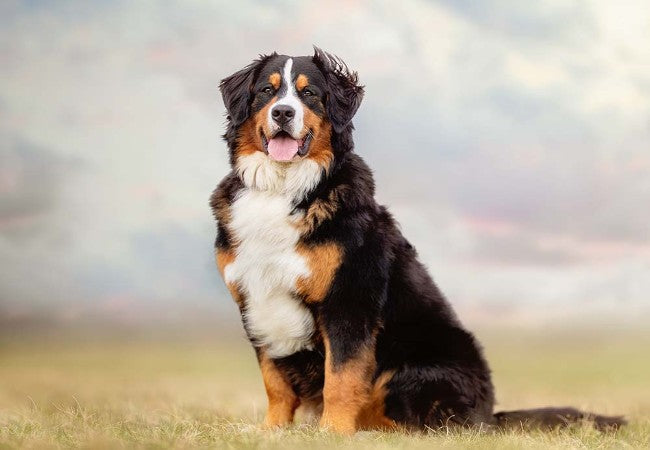Bernese Mountain Dog 2025 Guide: Care, Training & Family Fit 🐶✨

In this article
Bernese Mountain Dog 2025 Guide: Care, Training & Family Fit 🐶✨
By Dr. Duncan Houston BVSc
The Bernese Mountain Dog, also affectionately called the “Berner,” is a strikingly beautiful, tri‑colored working dog from the Swiss Alps. Known for its calm temperament, devotion, and versatility, this gentle giant forms deep bonds with families and brings a loving presence into any home.
History & Origins 📜
Hailing from the region around Bern, Switzerland, Berners were originally farm dogs used for drafting, cart-pulling, and herding cattle. Recognized as a breed by American breeders in the 1920s and officially by the AKC in 1937, they’ve retained their working instincts and affectionate nature.
Appearance & Physical Traits
- Height: 23–27.5 in at the shoulder; Weight: 70–115 lb
- Coat: Thick, long double coat in tricolor—black with white chest and rust accents
- Temperament: Strong build, expressive eyes, weather-resistant coat
Temperament & Personality 🧠
Berners are celebrated for their gentle and patient disposition. Typically calm and affectionate, they enjoy being close to family and are excellent with children and other pets, though some may be shy with strangers.
Exercise & Enrichment 🏃♂️
With moderate energy, Berners benefit from daily walks, play sessions, and hikes. They adapt well to indoor life when given opportunities to move and engage. Activities like cart-pulling and obedience exercises align well with their heritage.
Training & Socialization 🎓
Highly trainable and eager to please, Berners thrive on positive reinforcement. Early socialization helps build confidence and ease in varied environments. Consistent leash training is essential for their large size.
Grooming & Coat Care 🛁
- Brush several times per week to manage their heavy, year-round shedding
- Bath every 2–4 weeks using gentle dog shampoo
- Clean ears weekly and dry thoroughly after baths or swim
- Brush teeth regularly and trim nails monthly
- Use deshedding tools like the FURminator to maintain coat health
Nutrition & Feeding 🍽️
- Feed balanced AAFCO‑compliant food—for large breeds—to support growth and joint health
- For puppies, feed smaller frequent meals to reduce rapid weight gain
- Adults do well with two meals per day, avoiding elevated bowls to reduce bloat risk
- Omega-3s support skin, coat, joints, and heart health
- Encourage slow eating using puzzle or slow-feeder bowls
Health Considerations & Veterinary Care 🩺
Bernese Mountain Dogs have an average lifespan of 7–10 years and are prone to specific health issues:
- Gastric Dilatation-Volvulus (Bloat): Feed small meals, avoid vigorous exercise post‑meals, watch for bloating signs
- Cancer (especially histiocytic sarcoma): Watch for weight loss, lethargy; annual checks advised
- Hip/Elbow Dysplasia: Monitor mobility; consider screening Breeder/Sire/Dam
- Head Tremors: Benign shaking is common in Berners; usually not a quality‑of‑life concern
- Heart, eye, dental, and ear checks: Include these in regular wellness exams
Routine veterinary visits—annually before age 7, semiannually afterward—plus possible telemedicine support via Ask A Vet—can help with weight, aging, and chronic conditions.
Living Environment & Compatibility 🏠
- Best in homes with yards or near hiking spaces—cool climates are ideal
- Adaptable indoors when given sufficient exercise
- Excellent with children and other pets if socialized early
- May develop separation anxiety if left alone frequently
- High shedding means regular vacuuming and grooming commitment
Pros & Cons Summary
| Pros ✅ | Cons ⚠️ |
|---|---|
| Loving, patient, and family-centered | Heavy shedding and coat maintenance |
| Intelligent and trainable | Prone to serious health issues (bloat, cancer) |
| Strong working heritage and calm presence | Short lifespan relative to breed size |
| Good with children and other pets | Large size requires space and budget |
Final Thoughts from Dr Duncan Houston BVSc
The Bernese Mountain Dog brings heartwarming companionship, loyalty, and beauty into a home—but living with one means embracing grooming, exercise, and health planning. With structured training, enriching outdoor activities, reliable vet guidance, and grooming support, these gentle giants enrich families deeply—even if they stay with us for fewer years. 🐾






